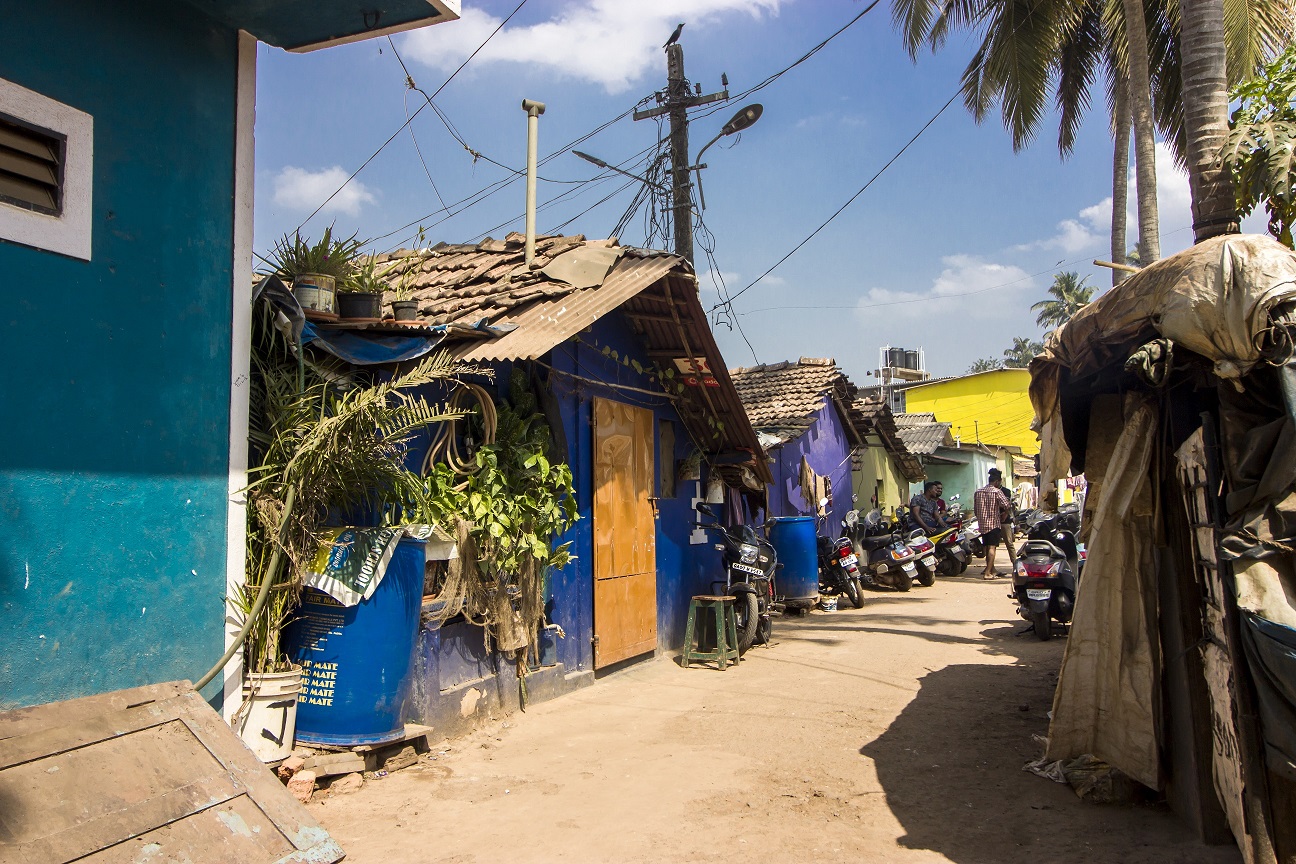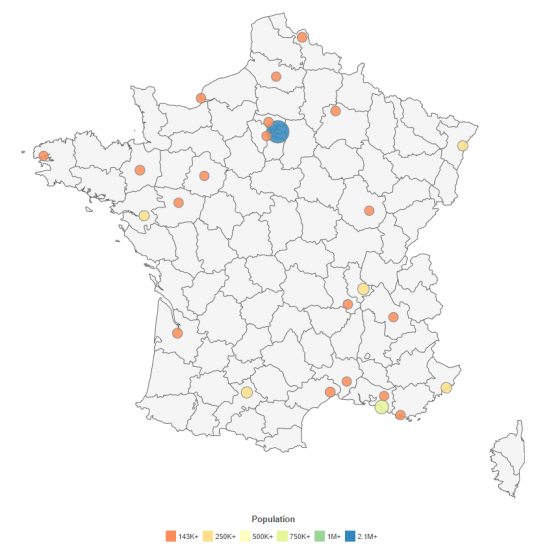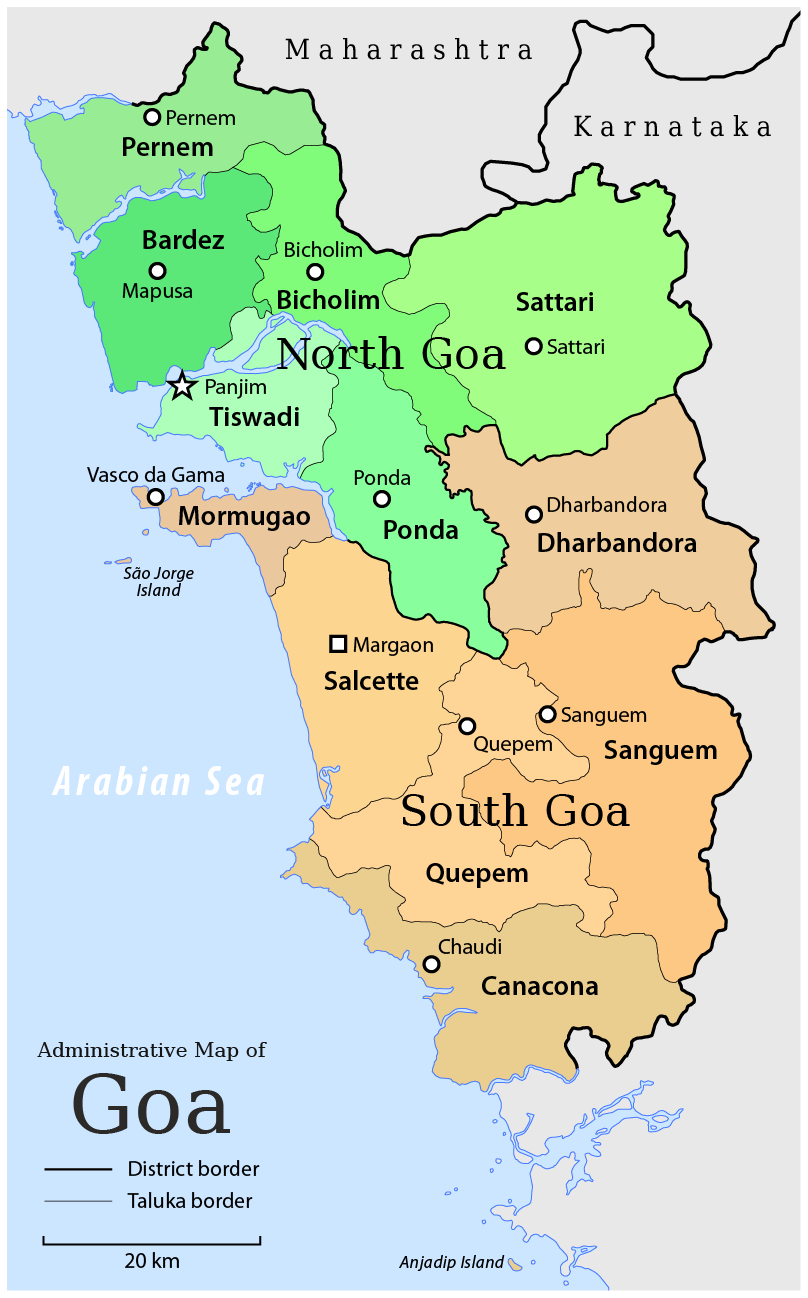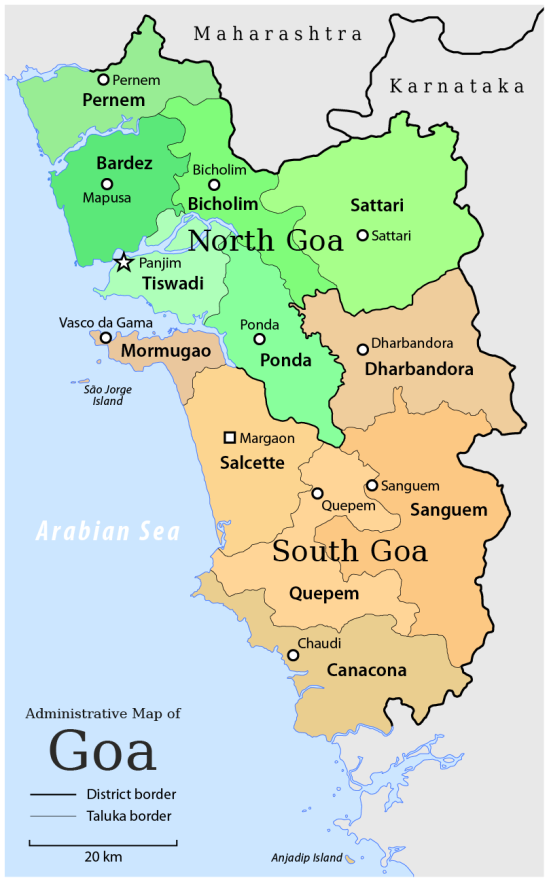Beyond the Urban-Rural Binary: France, Italy and Goa

Beyond the Urban-Rural Binary: France, Italy and Goa
The centralized form of urbanism is particularly apparent in France, which like most European countries experienced a rather late increase in its urban population. Only by 1930, the urban population of France became larger than its rural population. A rapid increase in urbanization started from 1945 to the 1970s and kept progressing steadily during the decades of high economic growth following World War II, and the economic shift caused by industrialization and capital accumulation through imperialist activities. Millions of people started to migrate from rural communities to urban dwellings hoping for a better life and higher salaries in the cities. This period was later called the “rural exodus” (Zarinetti 2006). Similar trends can be observed in other European countries (like England, Spain, or Germany), and like other European countries, the capital was not equipped for such a sudden onslaught of people. In addition, the ruins of World War II resulted in a severe housing shortage. The solution of the government, the development of large housing project building programs, resulted in overcrowded, small, and comfortless living spaces.
From 1970 there was an overall tendency to urban sprawl (Zarinetti, 2006). The concentration of population in and around Paris and its suburbs is also reflected in the overall spatial patterns of urbanization in France. Paris with 2.7 million inhabitants is by far the largest city in France. The suburbs of Paris are estimated to be populated by about 10.5 million people, which makes it the most populous urban area in the entire European Union (Paris Population 2022). There are no cities in France that are comparable to Paris in their economic, political, or cultural importance (see Figure 1). This development causes a lot of stress on the infrastructure of Paris. The immense spread of, many times hazardously grown, and aesthetically very unpleasing, suburbia is only one of the problems. Voices of citizens are rising, which are fed up with over-centralised urban agglomerations. The de facto model has encouraged a lot of unbalanced economic as well as urban developments in the country. Rural areas and local economies are left behind in terms of infrastructure, capital, and human resource availability. The difficulty and questionable endeavour of sustaining the project of megacities, in the long run, is becoming more and more evident.
On the other hand, as an example, of decentralised growth, we can take a quick look at the urban history of Italy. Italy experienced a very different urban development compared to France or England - a decentralised urban system. Surprisingly Italy was more prosperous compared to other European countries in the period of the late Middle Ages and Renaissance but experienced a downward draft and became rather poorer after the 16th century (Malanima 2005). In the History of Italy, there have been roughly three main phases of urbanisation over the past millennium. From the tenth century to 1350 Italy’s urbanisation was prospering, its urbanisation rate was twice as much as compared of other European countries. The population did not only increase in existing cities, new cities and centres also emerged. The north-central part of Italy developed into an important network of cities e.g., the Triangle of Florence, Venice, and Milan became the most important network point for commerce, trade, and investments. Reasons for the immense head start of Italy in terms of urbanisation rate are not completely certain. Some reasons could be favourable climatic conditions and stable agricultural production of food since in those times agricultural productivity was immediately related to the ratio of urban to the rural population. The second phase of urbanization dates from approximately 1350 to 1870. In these years the urbanisation rate suddenly diminished from 26% to less than 16%. This decrease was mainly caused by the plague which led to a massive decline in population, especially in the cities (Malanima 2005). The countryside was considerably less affected and for the first time the main driver of urbanisation, higher wages in the cities, disappeared. The situation reversed, resulting in a higher demand for rural labour and higher wages in the agricultural sector. At this point, Italy’s population began to sprinkle over the countryside and the population in cities continued to decline further with the beginning of the 19th century. Simultaneously other (northern-) European countries experienced a twofold increase in their urbanisation rates, with a sharp acceleration between 1800-1850. Italy, which had previously been the focal point of economic activities for Europe could obviously no longer sustain its economic importance. Only from the end of the 19th century did Italy’s economy and urban growth slowly reach back to a western European average. Once again people started to migrate from the countryside to the most industrialised communes (Malanima 2005). But due to the reversed history of Italy’s urbanisation, the centres of importance are many, rather smaller and specialized activities happen in multiple centres. The result is a spatially dispersed, polycentric network of settlements.
The example of Italy indicates that there are and always have been alternative forms of urbanism, without resulting in an unreasonably big city, creating a healthier urban and economic balance. The rise of the capitalist society during the 19th and 20th centuries allowed more imbalanced urbanism to evolve, even though impulses for decentralised systems had also been there.
This is where I want to come back to the place where we started, Goa. I want to introduce Goa as an idea of alternative urbanism. Looking at Goa more deeply can help us understand a way of urbanism, which doesn’t have to follow the trajectory of a big city. Urbanization of Goa has a long history, Archaeological remarks about the port city of Chandrapur with an estimated population of 25,000 to 75,000 are occurring from the 7th to 8th century A.D (Kamat, 2001). The city could not sustain the floods and the accumulation of silt from the river which caused the inaccessibility of the port over time and led to the city’s slow deterioration. During the 10th to 14th century arose the glorious medieval city of Gopakapattna, it had remarkable extended trade with various ports in the Indian Ocean region, the estimated population of the city ranges from 25,000 to 100,000. Eventually, the sediment accumulation again led to the inaccessibility of the port and forced the merchants to relocate. The new settlement set the foundation of the city of Old Goa in the 14th century. The city of Old Goa grew from the 14th to the 15th century to an estimated population of over 100,000. At the beginning of the 16th century, it had flourished into an impressive urban centre with the character of a cosmopolitan port city (Kamat, 2001). Unfortunately, the urban design was a disaster in terms of drainage, sanitation, and public health and at the end of the 18th century, epidemics brought an end to its golden era.
The Portuguese took the learnings from the downfall of Old Goa when they developed the new townships. Entering the period of colonial Urbanism in Goa from the mid-19th century the cities Panjim, Mapusa, Margao, Ponda and Marmagoa developed. Each of these settlements developed its unique specialisations. Margao was soon connected to the Indian railway line, and Panjim expanded as a port city and a centre of administration. Mapusa became a hotspot for the trade of goods and Ponda was important for the marketing of agricultural raw materials. The number of townships and the percentage of urban population increased drastically during the past 70 years (Kamat, 2001). The coastal belt of India is rapidly urbanizing, and according to the Census of India, Goa has become the most urbanised with 62% of its population categorised as urban (Ideas Unleashed). We are now entering into a new phase of urbanism in Goa, also, in some sources called as RUrbanism, which describes the progressive blur of its rural and urban areas, showing mixed elements of rural and urban traits in its settlements. Even though Goa is experiencing high levels of urbanisation there is no single city that is superior to others or exceeds a million-plus people (Ideas Unleashed). Nonetheless, does the urban spread of its existing cities pressures the natural ecosystems, such as the mangroves and sand, the coconut orchards and paddy fields in and around cities (Kamat, 2001).
When we compare Goa to Mumbai we can see two very different models of urbanism, even though both places are in geographical proximity, both lie on the Konkan coast of India and experience similar climatic conditions. Mumbai is concentrating a dense population at a specific point although its physical shape and size are much smaller than that of Goa. The total area of Mumbai with 603 sq km is six times smaller than the total area of Goa, which is 3702 sq km, but Mumbai holds a total population of 20 million inhabitants (Census 2011), which is more than eleven times more than Goa, with only 1.7 million inhabitants (Census 2011). As already pointed out previously, Mumbai became a metropolis through the ambitions of the English invaders whereas Goa with its bigger landmass but smaller population never developed into a city of exclusive primary importance (Revi et al. 2006). In contrast, Goa has grown along many nodal points (Figure 2). From this perspective we can compare Mumbai to Paris in France and Goa can be looked upon as a version of decentralized urbanism, similar to Italy.
Today Goa is undermining its village structure, to strengthen the village structure would enhance the overall infrastructure. Too much “order” and segregation of activities could erase diversity and the segregation of land use from “urban” (settlement and commercial activities) and “rural” (agriculture and uninhabited land) would lead to a loss of Goa's unique urbanisation patterns and culture. Many cities such as Panjim integrate farming, patty fields and vegetable farms as they stretch in strips through the city and are an essential part of its urban fabric. Goa does face struggles when it comes to recent urban developments, but it is still excellently functional since the core of Goa's spatial logic is still intact. For example, Goa’s villages have emerged around the river and water system. Now a reorientation along the highways is taking place, facing the issues of air pollution and traffic congestion. But Goa has the potential to solve these problems, as Charles Correa already suggested, the 255 km of navigable waterways of Goa have the potential for an extensive water network and can cater to the local population as well as tourists. Adapting the river transport system which is already in place, could contribute to more efficient and affordable mobility (CCF Goa, 2018). Studies exist, that have considered Panjim, the capital of Goa with its rich natural resource base and community-centric culture as a powerful basis as an alternative model of urbanism
Generalizations about urbanism and urban society are mostly derived from a single form of urbanism, which occurred during the past 500 years, as a side effect of the expansion of the capitalist system...
Opposing urban to rural originates in this perception of urbanization and neglects the fact, that all human agglomerations have similar functions regarding an inclusive society, the creation of flows of exchange, transfer, and communications, and is interlinked with other settlements around them- contributing to society as an integral part, as a part of the total system. Further, all members of a system, which contains towns or cities can be called an urban society, including the rural and agricultural domains. Rather than creating a two-class society associated with the terms rural and urban, the term 'rural' can be applied to a set of specialities of urban society. “ 'rural' and 'urban' indeed obfuscate what are, in fact, much more complex structures ” (Leeds, 2017).
Goa is an example of a vibrant urban culture within dense yet dispersed cities (Revi et al. 2006). This can be seen as a new opportunity to shift the paradigm of centralized growth and to include the rural and the urban as a single space — not two spaces, as is now the case. This could also be an opportunity for Asia, to answer the developmental dilemma that urbanization has produced in the West, and has left most of the countryside industrialized, suburbanized, or prettified (Tay, 2008). Revision of the relationship between capitalism and the city, and the urban-rural binary might lead to new solutions. We question the megacities as symbols of advanced capitalism and industrialization. Are there no better solutions? The growth model is doubtful if it results in further environmental destruction. Cities don’t need to be one centralized agglomeration but can also function like a living web spread over valleys and waterways, co-existing with farms and plantation forests. Can we create such a future of RUrbanism: coevolution of the countryside and of the city that is embedded within it? Goa was chosen as an example since it already demonstrates an alternative urban and has the potential to develop further into a sustainable model of urban future. Goa needs to be understood as an urban system, not as a city. This view also supports Anthony Leeds' (2017) thesis that the usual linear thinking of urbanization does not apply to societies as they are complex networks. Generalizations about urbanism and urban society are mostly derived from a single form of urbanism, which occurred during the past 500 years, as a side effect of the expansion of the capitalist system. As Leeds calls it the evolution of “the capitalist city in urban capitalist society”. Opposing urban to rural originates in this perception of urbanization and neglects the fact, that all human agglomerations have similar functions regarding an inclusive society, the creation of flows of exchange, transfer, and communications, and is interlinked with other settlements around them- contributing to society as an integral part, as a part of the total system. Further, all members of a system, which contains towns or cities can be called an urban society, including the rural and agricultural domains. Rather than creating a two-class society associated with the terms rural and urban, the term 'rural' can be applied to a set of specialities of urban society. “ 'rural' and 'urban' indeed obfuscate what are, in fact, much more complex structures ” (Leeds, 2017).
India is currently experiencing a highly imbalanced growth of its urban system. The population is concentrating and expanding vertically around the large cities and horizontally in the peri-urban areas (Tripathi, 2021). Even though Indian cities are repeatedly referred to as “engines of economic growth”, they are largely unsustainable, more and more congested and it has therefore become difficult to manage and provide basic infrastructure and services. Encouraging polycentric growth and population sizes of smaller towns can help lessen the dominance of population concentration in megacities (Tripathi, 2021). The portrait of megacities is outdated and small towns and alternative forms of urbanism such as those explored in the example of Goa can impart a more sustainable future and higher quality of life.
You can access part 1 here.
Bibliography
BISWAS, A. (2015). Urbanization in India: a pre-colonial experience, Chapter 1. National Knowledge Network NORTH BENGAL UNIVERSITY, 1-28. http://14.139.211.59/bitstream/123456789/1226/6/06_chapter_1.pdf
BENEDICT, P. (1990). Was the Eighteenth Century an Era of Urbanization in France? The Journal of Interdisciplinary History, 21(2), 179–215. https://doi.org/10.2307/204404
FERNANDES, A. (2008). Local power in colonial and contemporary Goa Pouvoir local à Goa, coloniale et contemporaine Poder local na Goa colonial e contemporânea. Lusotopie, 15, 151-173.
KAMAT, N.M. (2001). Urbanisation in Goa. The past 2000 years: a short review. Govapuri. 3(1); 2001; 6-11. http://irgu.unigoa.ac.in/drs/handle/unigoa/513
LEEDS, A. (2017). Cities, Classes, and the Social Order, edited by Roger Sanjek, Cornell University Press, Ithaca. 64-261. http://ebookcentral.proquest.com/lib/huberlin-ebooks/detail.action?docID=4799672
MALANIMA, P. (2005). Urbanisation and the Italian economy during the last millennium. European Review of Economic History, 9(1), 97–122. http://www.jstor.org/stable/41378414
REVI, A. et al. (2006). Goa 2100: the transition to a sustainable RUrban design. Environment and Urbanization. 18(1), 51–65. DOI: 10.1177/0956247806063941.
ROMANO, B. et al. (2017). Land transformation of Italy due to half a century of urbanization, Land Use Policy, Volume 67, 387-400. https://doi.org/10.1016/j.landusepol.2017.06.006
TAY, K.S. (2008). Behold the Countryside: The Urban/Rural Divide. Global Asia (East Asia Foundation), 3(3), 48–55.
TRIPATHI, S. (2021). Towards a sustainable urban system through the development of small towns in India. Reg Sci Policy Pract; 13: 777– 797. https://doi.org/10.1111/rsp3.12424
ZARINETTI, J.M. (2006). Urban sprawl in France: a regional typology of urbanization trends and its demographic and economic background. Bulletin of Geography. Socio-Economic Series nr 5, 5-20
Online Resources:
CCF Goa: River Transportation – Inland Waterways, Charles Correa Foundation, Panjim, Goa. (Erstellt: 2018, Abruf: 30.03.2022) URL:https://charlescorreafoundation.org/2018/04/19/river-transportation-inland-waterways/#more-3099
Ideas Unleashed. ICG-Goa University Essay Competition. IVth Edition. The Challenges of Urbanisation in Goa. (Created: 2020, Accessed 30.03.2022) URL: http://www.internationalcentregoa.com/wp-content/uploads/2020/01/IVth_Edition_of_Ideas_Unleashed-Concept_Note-English.pdf
Mumbai History. (Created: 2006, Accessed: 26.03.2022) URL:https://www.mumbai.org.uk/index.html
Paris Population 2022, information based on The National Institute of Statistics and Economic Studies and Urbistat Paris. (Created: 2022, Accessed: 27.03.2022) URL: https://ugeo.urbistat.com/AdminStat/en/fr/demografia/dati-sintesi/paris/75/3





